高一英语导学案初高中英语知识衔接修订稿
- 格式:docx
- 大小:133.94 KB
- 文档页数:22
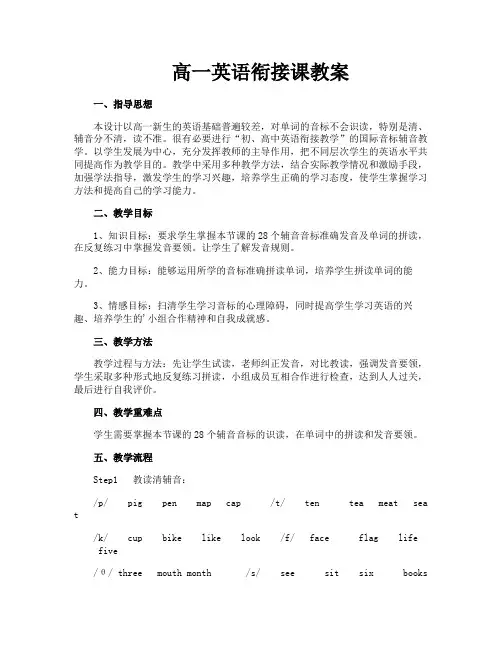
高一英语衔接课教案一、指导思想本设计以高一新生的英语基础普遍较差,对单词的音标不会识读,特别是清、辅音分不清,读不准。
很有必要进行“初、高中英语衔接教学”的国际音标辅音教学。
以学生发展为中心,充分发挥教师的主导作用,把不同层次学生的英语水平共同提高作为教学目的。
教学中采用多种教学方法,结合实际教学情况和激励手段,加强学法指导,激发学生的学习兴趣,培养学生正确的学习态度,使学生掌握学习方法和提高自己的学习能力。
二、教学目标1、知识目标:要求学生掌握本节课的28个辅音音标准确发音及单词的拼读,在反复练习中掌握发音要领。
让学生了解发音规则。
2、能力目标:能够运用所学的音标准确拼读单词,培养学生拼读单词的能力。
3、情感目标:扫清学生学习音标的心理障碍,同时提高学生学习英语的兴趣、培养学生的'小组合作精神和自我成就感。
三、教学方法教学过程与方法:先让学生试读,老师纠正发音,对比教读,强调发音要领,学生采取多种形式地反复练习拼读,小组成员互相合作进行检查,达到人人过关,最后进行自我评价。
四、教学重难点学生需要掌握本节课的28个辅音音标的识读,在单词中的拼读和发音要领。
五、教学流程Step1 教读清辅音:/p/ pig pen map cap /t/ ten tea meat sea t/k/ cup bike like look /f/ face flag life five/θ/ three mouth month /s/ see sit six books// wash fish wishfinish /h/ her history house high/t/ teacher match touch /ts/ students seats/tr/ tree try trouble发音要领:清辅音,发音时声带不震动,送气要强。
Step2 教读浊辅音:/b/ bat baby bag bee /d/ dog door bed blood/g/ goat group green /v/ five live move vast// this though their /z/ zoo zero// usually television /r/red rule rude/d/ jeep orange /dz/ words goods/dr/ driver draw /j/ yellow year yes/w/ we week west /m/ milk meat minute/n/ nice net nose // thing think long/l/ look ruler ball all发音要领:浊辅音,发音时声带必须震动, 在词末时不要加上元音。
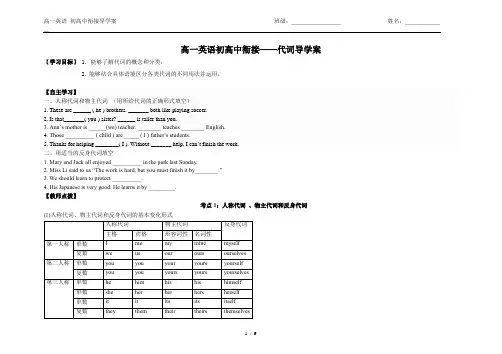
高一英语初高中衔接——代词导学案【学习目标】 1. 能够了解代词的概念和分类;2.能够结合具体语境区分各类代词的不同用法并运用。
【自主学习】一、人称代词和物主代词(用所给代词的正确形式填空)1. These are ______ ( he ) brothers. _______ both like playing soccer.2. Is that_______( you ) sister? ______ is taller than you.3. Ann’s mother is ______(we) teacher. ________ teaches ________ English.4. Those __________ ( child ) are _____ ( I ) father’s students.5. Thanks for helping ________( I ). Without _______ help, I can’t finish the work.二、用适当的反身代词填空1. Mary and Jack all enjoyed __________ in the park last Sunday.2. Miss Li said to us “The work is hard, but you must finish it by________.”3. We should learn to protect __________.4. His Japanese is very good. He learns it by _________.【教师点拨】考点1:人称代词、物主代词和反身代词(1)人称代词、物主代词和反身代词的基本变化形式人称代词物主代词反身代词主格宾格形容词性名词性第一人称单数I me my mine myself复数we us our ours ourselves第二人称单数you you your yours yourself复数you you yours yours yourselves第三人称单数he him his his himself单数she her her hers herself单数it it its its itself复数they them their theirs themselves(2) 人称代词的用法:① 主格通常放在动词前面。
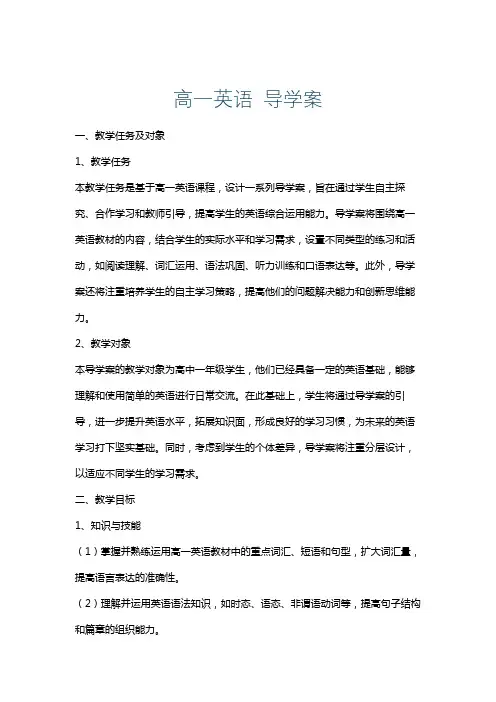
高一英语 导学案一、教学任务及对象1、教学任务本教学任务是基于高一英语课程,设计一系列导学案,旨在通过学生自主探究、合作学习和教师引导,提高学生的英语综合运用能力。
导学案将围绕高一英语教材的内容,结合学生的实际水平和学习需求,设置不同类型的练习和活动,如阅读理解、词汇运用、语法巩固、听力训练和口语表达等。
此外,导学案还将注重培养学生的自主学习策略,提高他们的问题解决能力和创新思维能力。
2、教学对象本导学案的教学对象为高中一年级学生,他们已经具备一定的英语基础,能够理解和使用简单的英语进行日常交流。
在此基础上,学生将通过导学案的引导,进一步提升英语水平,拓展知识面,形成良好的学习习惯,为未来的英语学习打下坚实基础。
同时,考虑到学生的个体差异,导学案将注重分层设计,以适应不同学生的学习需求。
二、教学目标1、知识与技能(1)掌握并熟练运用高一英语教材中的重点词汇、短语和句型,扩大词汇量,提高语言表达的准确性。
(2)理解并运用英语语法知识,如时态、语态、非谓语动词等,提高句子结构和篇章的组织能力。
(3)提高阅读理解能力,能够快速捕捉文章主旨,分析文章结构,理解作者观点和意图。
(4)提高听力水平,能够准确理解日常英语对话、新闻报道和故事等内容。
(5)培养良好的口语表达能力,能够就所学话题进行讨论、发表见解和进行角色扮演等。
(6)掌握一定的写作技巧,能够独立完成各类作文,如记叙文、说明文、议论文等。
2、过程与方法(1)采用自主学习、合作学习和探究学习等方法,引导学生主动参与教学活动,培养其独立思考和解决问题的能力。
(2)运用多媒体教学资源,如网络、视频、音频等,丰富教学手段,提高学生的学习兴趣和积极性。
(3)通过课堂讨论、小组活动、课后作业等多种形式,巩固所学知识,形成良好的学习习惯。
(4)注重学习策略的培养,让学生学会如何有效地预习、复习和总结,提高学习效率。
3、情感,态度与价值观(1)培养学生对英语学习的兴趣和热情,使其树立自信心,勇于面对英语学习中的困难和挑战。
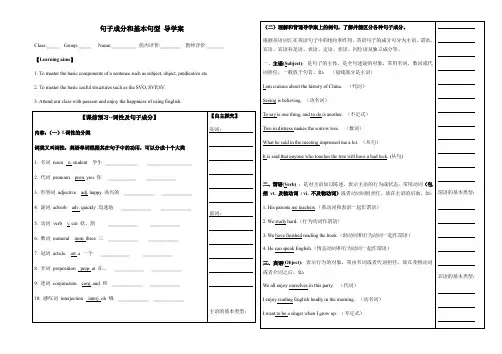
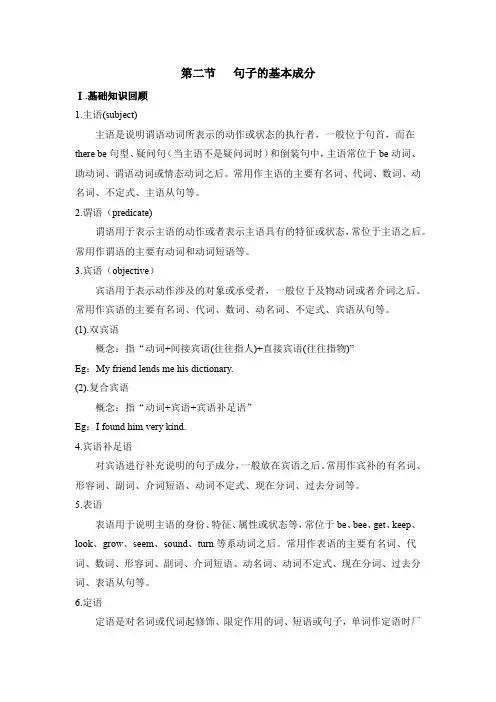
第二节句子的基本成分Ⅰ.基础知识回顾1.主语(subject)主语是说明谓语动词所表示的动作或状态的执行者,一般位于句首,而在there be句型、疑问句(当主语不是疑问词时)和倒装句中,主语常位于be动词、助动词、谓语动词或情态动词之后。
常用作主语的主要有名词、代词、数词、动名词、不定式、主语从句等。
2.谓语(predicate)谓语用于表示主语的动作或者表示主语具有的特征或状态,常位于主语之后。
常用作谓语的主要有动词和动词短语等。
3.宾语(objective)宾语用于表示动作涉及的对象或承受者,一般位于及物动词或者介词之后。
常用作宾语的主要有名词、代词、数词、动名词、不定式、宾语从句等。
(1).双宾语概念:指“动词+间接宾语(往往指人)+直接宾语(往往指物)”Eg:My friend lends me his dictionary.(2).复合宾语概念:指“动词+宾语+宾语补足语”Eg:I found him very kind.4.宾语补足语对宾语进行补充说明的句子成分,一般放在宾语之后。
常用作宾补的有名词、形容词、副词、介词短语、动词不定式、现在分词、过去分词等。
5.表语表语用于说明主语的身份、特征、属性或状态等,常位于be、bee、get、keep、look、grow、seem、sound、turn等系动词之后。
常用作表语的主要有名词、代词、数词、形容词、副词、介词短语、动名词、动词不定式、现在分词、过去分词、表语从句等。
6.定语定语是对名词或代词起修饰、限定作用的词、短语或句子,单词作定语时厂房在被修饰词之前,而短语或句子作定语时,往往放在被修饰词之后。
常用作定语的有名词、代词、数词、形容词、副词、介词短语、动名词、动词不定式、现在分词、过去分词、定语从句等。
7.状语状语用于修饰动词、形容词、副词、其它状语或整个句子,说明动作或状态的特征,以及时间、地点、原因、目的等,其位置不固定。
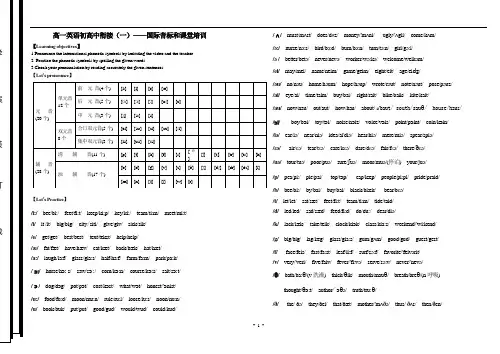
高一英语初高中衔接(一)——国际音标和课堂培训【Learning objectives 】1.Pronounce the international phonetic symbols by imitating the video and the teacher.2. Practice the phonetic symbols by spelling the given words.3.Check your pronunciation by reading accurately the given sentences. 【Let ’s pronounce 】【Let ’s Practice 】/i:/ bee/bi:/ feet/fi:t/ keep/ki:p/ key/ki:/ team/ti:m/ meet/mi:t/ /i/ it /it/ big/big/ city /siti/ give/giv/ sick/sik/ /e/ get/get/ best/best/ text/tekst/ help/help/ /æ/ fat/fæt/ have/hæv/ cat/kæt/ back/bæk/ hat/hæt/ /a:/ laugh/la:f/ glass/gla:s/ half/ha:f/ farm/fa:m/ park/pa:k/ / ɔ:/ horse/h ɔ: s/ saw/s ɔ:/ corn/k ɔ:n/ course/k ɔ:s/ salt/s ɔ:t/ / ɔ / dog/d ɔg/ pot/p ɔt/ cost/k ɔst/ what/w ɔt/ honest/′ɔnist/ /u:/ food/fu:d/ moon/mu:n/ rule/ru:l/ loose/lu:s/ noon/nu:n/ /u/ book/buk/ put/put/ good/gud/ would/wud/ could/kud// ʌ / must/m ʌst/ does/d ʌz/ money/′m ʌni/ ugly/′ʌgli/ come/k ʌm/ /ə:/ nurse/n ə:s/ bird/b ə:d/ burn/b ə:n/ turn/t ə:n/ girl/g ə:l/ /ə / better/bet ə/ never/nev ə/ worker/w ə:k ə/ welcome/welk əm/ /ei/ may/mei/ name/neim/ game/geim/ eight/eit/ age/ei d ʒ//əu/ no/n əu/ home/h əum/ hope/h əup/ wrote/r əut/ note/n əut/ pose/p əuz/ /ai/ eye/ai/ time/taim/ buy/bai/ right/rait/ bike/baik/ kite/kait//au/ now/nau/ out/aut/ how/hau/ about/ ə′b au t/ south/s au θ/ house/h aus //ɔi / boy/b ɔi/ toy/t ɔi/ noise/n ɔiz/ voice/v ɔis/ point/p ɔint/ coin/k ɔin/ /i ə/ ear/i ə/ near/ni ə/ idea/ai ′di ə/ hear/hi ə/ mere/mi ə/ spear/spi ə//εə/ air/εə/ tear/t εə/ care/k εə/ dare/d εə/ fair/f εə/ there/ðεə//u ə/ tour/tu ə/ poor/pu ə/ sure/ʃu ə/ moor/mu ə/(停泊) your/ju ə/ /p/ pea/pi:/ pie/pai/ top/t ɔp/ cap/kæp/ people/pi:pl/ pride/praid/ /b/ bee/bi:/ by/bai/ buy/bai/ black/blæk/ bear/b εə/ /t/ let/let/ sat/sæt/ feet/fi:t/ team/ti:m/ tide/taid/ /d/ led/led/ sad/sæd/ feed/fi:d/ do/du:/ dear/di ə//k/ lack/læk/ take/teik/ clock/kl ɔk/ class/kla:s/ weekend/′wi:kend/ /g/ big/big/ lag/læg/ glass/gla:s/ gum/g ʌm/ good/gud/ guest/gest/ /f/ face/feis/ fast/fa:st/ leaf/li:f/ surf/s ə:f/ favorite/′feiv ərit/ /v/ very/′veri/ five/faiv/ fever/′fi:v ə/ serve/s ə:v/ never/′nev ə/ /θ/ bath/ba:θ/(v 洗澡) thick/θik/ mouth/mau θ/ breath/bre θ/(n 呼吸)thought/θɔ:t/ author/´ɔθə/ truth/tru:θ//ð/ the/ ðə/ they/ðei/ that/ðæt/ mother/′m ʌðə/ thus/ ðʌs/ then/ðen/元音 (20个)单元音12个前 元 音(4个)[i:][i][e] [æ] 后 元 音(5个)[ɑ:] [ɔ:] [ɔ] [u:] [u]中 元 音(3个) [ʌ] [ə:][ə]双元音8个合口双元音(5个) [ei] [əu] [ai][au] [ɔi]集中双元音(3个)[i ə] [u ə] [ɛə]辅音(28个)清 辅 音(11个)[p] [t] [k] [f] [s] [θ] [ʃ] [t ʃ][tr][ts][h] 浊 辅 音(17个)[b][d][g] [v] [z][ð][ʒ] [d ʒ] [dr] [dz] [l] [m] [n][ŋ][j][w] [r]学案装订线学案装订线/s/ face/feis/ mouse/maus/ cakes/keiks/ caps/kæps/ likes/laiks/ stops/stɔps//z/ close/kləuz/ keys/ki:z/ boys/bɔi z/ pens/penz/ halves/ha:vz//tʃ/ catch/kætʃ/ cheep/tʃi:p/ rich/ri tʃ/ watch/w tʃ/ child/tʃaild/ question/kwes tʃən/ teach/ti:tʃ/ challenge/tʃlin dʒ//dʒ/orange/′ɔri dʒ/ large/la:dʒ/ juice/dʒu:s/ job/dʒɔb//tr/tree/tri:/ try/trai/ true/tru:/ trouble/traubl/ track/træk//dr/ dry/drai/ dream/dri:m/ dress/dres/ drink/driŋk/ hundred/′hʌndrid//ʃ/ she/ʃi:/ sharp/ʃa:p/ fish/fiʃ/ shock/ʃɔk/ shoe/ʃu://ʒ/pleasure/′pleʒə/ measure/′meʒə/ television/′teliviʒən//ts/let′s/lets/ sports/spɔ:ts/ puts/puts/ writes/raits/ seats/si:ts//dz/ hands/hændz/ birds/bə:dz/ friends/freindz/ beds/bedz/ stands/stændz//h/ he/ hi:/ hard/ha:d/ him/him/ heard/hə:d/ half/ha:f//l/like/laik/ late/leit/ learn/lə:n/ lead/li:d/ light/lait//m/ my/mai/ more/mɔ:/ seem/si:m/ meat/mi:t/ mind/maind/ men/men//n/nice/nais/ wind/waind/ mind/maind/ rain/rein/ fine/fain//ŋ/ sing/siŋ/ wing/wiŋ/ ring/riŋ/ long/lɔŋ/ beautiful/bju:təfl//j/you/ju:/ few/fju:/ yard/ja:d/ music/′mju:zik/ student/′stju:dnt/ excuse/ik′skju:z//w/ work/wə:k/ way/wei/ well/wel/ what/wɔt/ twelve/twelv/ twin/twin//r/ red/red/ road/rəud/ write/rait/ wrong/rɔŋ/【Let’s Check】I.根据音标,选择正确的单词。
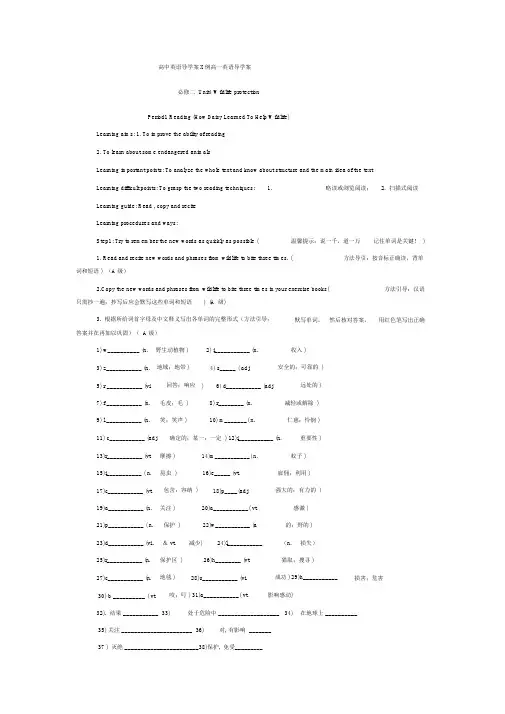
高中英语导学案X例高一英语导学案必修二 Unit4 Wildlife protectionPeriod1 Reading (How Daisy Learned To Help Wildlife)Learning aims: 1. To improve the ability of reading2. To learn about some endangered animalsLearning important points: To analyze the whole text and know about structure and the main idea of the textLearning difficult points: To grasp the two reading techniques: 1.略读或浏览阅读; 2. 扫描式阅读Learning guide: Read , copy and reciteLearning procedures and ways:Step1: Try to remember the new words as quickly as possible (温馨提示:说一千,道一万记住单词是关键! )1. Read and recite new words and phrases from wildlife to bite three times. (方法导引:按音标正确读,背单词和短语 ) (A 级)2.Copy the new words and phrases from wildlife to bite three times in your exercise books(方法引导:汉语只需抄一遍;抄写后应会默写这些单词和短语)(A 级)3. 根据所给词首字母及中文释义写出各单词的完整形式(方法引导:默写单词,然后核对答案,用红色笔写出正确答案并在再加以巩固)( A 级)1) w__________ (n.野生动植物 )2) i___________ (n.收入 )3) z___________ (n.地域;地带 )4) s_____ ( adj.安全的;可靠的 )5) r ___________ (vi.回答;响应)6) d___________ (adj.远处的 )7) f ___________ (n.毛皮;毛 )8) r________ (n.减轻或解除 )9) l ___________ (n.笑;笑声 )10) m_______( n.仁慈;怜悯 )11) c___________ (adj.确定的;某一;一定 ) 12)i___________ (n.重要性 )13)r___________ (vt摩擦 )14)m___________( n.蚊子 )15)i___________ ( n.昆虫 )16)e_____ (vt.雇佣;利用 )17)c___________ (vt.包含;容纳 )18)p____(adj.强大的;有力的 )19)a___________ (n.关注 )20)a___________( vt.感激 )21)p___________ ( n.保护 )22)w___________ (a的;野的 )23)d___________ (vi .& vt.减少)24)l___________(n.损失)25)r___________ (n.保护区 )26)h________ (vt.猎取;搜寻 )27)c___________ (n.地毯 )28)s___________ (vi.成功 ) 29)h___________损害;危害30) b __________ ( vt.咬;叮 ) 31)a___________( vt.影响感动)32). 结果 ___________ 33)处于危险中 ___________________ 34)在地球上 __________35) 关注 ______________________ 36)对, 有影响 _______37 ) 灭绝 _______________________38)保护,免受_________39) 保护区_______________40)平静地_______________Step2:Look through the text HOW DAISY LEARNED TO HELP WILDLIFE and get the main idea of it. (方法引导:略读或浏览阅读,忽略不懂的句子和生词,快速阅读课文。


树人中学2020届高一英语导学案(2)--时态班级:高一段编制人:李小琴份数:380 日期:2017-8.05 姓名:______________ 班级:_______________ 英语中一共有十六种时态,初中阶段主要学习了八种时态,主要包括一般现在时,一般过去时,一般将来时,现在进行时,现在完成时,过去进行时,过去将来时和过去完成时,高中强化并熟练运用以上时态并增加了解其他时态。
一、一般现在时1.用法:1)表示现阶段经常性,习惯性的动作或存在的状态、特征或客观真理。
常用的时间状语有often ,usually ,sometimes ,always ,every day ,never ,in the morning,every week/day 等。
现场演练(汉译英):①我每天早晨六点起床____________________________________(经常性动作)②他每周打网球一次______________________________________(习惯性动作)③太阳从东方升起______________________________________(rise)(客观真理)④我母亲是个老师,她在一所中语教学.__________________________________________________________________________________________________________________________(现在的状态)I get up at six every morning. (经常性动作)He plays tennis once a week. (习惯性动作)The sun rises in the east. (客观真理)My mother is a teacher. She teaches English in a school. (现在的状态)2) 在条件状语从句和时间状语从句中用一般现在时表示将来。

2016级高一年级初高中衔接导学案(音标)Practice makes perfect.同学们,学英语就如同刷牙,每天都要开口朗读,这对于英语的学习能够起到事半功倍的效果。
朗读的前提是正确的认读发音,而音标的学习是这一切的基础。
希望同学们认真对待,真正掌握基本的语音知识,并熟练地运用到单词的记忆和课文的朗读中去。
一、请在四线格上正确书写26个字母。
二.请将26个字母按不同的元音因素分类。
1)含元音音素[ei]字母: Aa Hh Jj Kk音标: [ei] [eit∫][d3ei] [kei]2) 含元音音素[i:]字母: Bb Cc Dd Ee Gg Pp Tt Vv Zz音标: [bi:] [si:] [di:] [i:] [d3i:] [pi:] [ti:] [vi:] [zi:]3) 含元音音素[e]字母: Ff Ll Mm Nn Ss Xx Zz音标: [ef] [el] [em] [en] [es] [eks] [zed]4) 含元音音素[ju:]字母: Uu Qq Ww音标: [ju:] [kju:] [`d∧blju:]5) 含元音音素[ai] 字母: Ii Yy6) Rr三、请写出26个字母的完整音标(可写在第一或第二题的字母旁边)。
四、朗读下列单词,并划出含有相同音素的字母或字母组合。
[ i: ] m e b ee s ea t bel ie ve rec ei ve[ i ] s i t b i t k i ck p i ck w i sh[ e ] p e n b e g e gg br ea d m a rry a ny[æ] cap map bad mad bank thank lamp[ə: ] work bird term burn learn[ə ] again teacher doctor famous[a:] far dark heart half[ʌ] up but luck monk onion[u:] food cool tomb group blue rule[u] foot good cook pull full should[ɔ:] talk call door saw bought thought before caught born warn [ɔ] on not cop rot hot lot[ei] eight cake name paid day[ai] cry my kite high time buy guy[ɔɪ] toy boy noise point soil oil[au] house sound out bow town[əu] host nose bowl know boat coat[iə] beer deer hear near fear here[ɛə] hair chair bear swear dare there[uə] poor sure tour[ k ] come kite pick back[ f ] life five telephone photo[ v ] live five very vase[θ]think thank thought teeth truth fifth mouth[ð] this that these those than though[ʃ] ship sure machine action official Asian[3] pleasure usual leisure measure[ s ] seem books mouse face price[ z ] zoo prize raise eyes his[ h ] hot hate high whole who[ r ] race free pray wrong write[ tʃ] cheap child check catch watch[d3] jeep joke juice change judge[ tr ] tree treat trip train tram[ dr ] dream drag draw drink children[ ts ] sits seats mates peasants parents[ dz ] needs seeds spends[ŋ]sing song ink sink thank tank[ l ]清晰音let late laid leap lap含糊音deal tell belt sale table[ w ] wait west wheel what while[ j ] year yes yet yard young you你发现字母及常见字母组合的发音规律了吗?朗读这些单词,记住其中的字母和组合的发音,可以提高你今后的单词拼读技巧哦!五、将Unit 1的单词按音节分类,并将音标补充完整。

高一英语初高中英语知识衔接学案一、音标第一课时设计教师:田秋荣教师心语:通过多年的教学实践,我们深深地感到:要学好外语,一定要首先掌握好国际音标,这样才能通过语音关,希望在这节课后,同学们可以掌握好48个国际音标的发音。
关键词:字母,音素,音标毎一个英语单词都有书写形式和语音形式,字母是词的书写形式,音标是词的语音形式,音素是语音的最小单位,如:food由4个字母组成,要读出food这个词,有3个音素:f-u:-d,把这3个音素放在方括号内就组成了音标。
英语共有48个国际音标。
一、本节学习目标:掌握48个音素的正确读法二、学习重点:20个元音三、学习难点:[f][v] [s] [z] [f] [3] [0] [6] [tj] [d5] [ts] [dz] [tr] [dr]四、学习内容与过程:Step I (第一步)试读表中的每个音素,用红笔圈出自己不会读的音素英语国际标准音标元音单前元音(4个)D:]/i/[e][ae]后元音(5个)[3:]/D/[u:]/u/[a:]中元音(3个)/3:/[9][A]双元音8个/ei//ai//3I//«//es//U3//9U//au/辅音清辅音(n个)[p][t][k][f][s][6]tn[tj][tr][ts][h]浊辅音(17个)[b][d][g][V][Z][d]【3】[d3][dr]【dz][1] [m][n][n]U1[w][r]StepII.小组内交流学习个人不会读的音素,用绿色笔圈出同学帮助纠正但以前一直误读的音素; StepIII.板书小组成员都拿不准或不会读的音素。
StepIV.小组之间各派代表相互教读板书音素,教师适时帮助。
巩固练习:1.前元音/ i:/ bee/bi: / feet /fi:t/ keep /ki:p/ key /ki:/ team/ti:m/ meet /mi:t//i/ it /it/ big/big/ city/siti/ give/giv/ sick/sik//e / get/get/ best/best/ text/tekst/ help/help//ae / fat/faet/ have/haev/ cat/kaet/ back/baek/ hat/haet/2.后兀音/□:/ horse/hD: s/ saw/sD:/ corn/kD:n/ course/k3:s/ salt/s3:t//□ / dog /dug/ pot/pDt/ cost/kDst/ what/wDt/ honest/'Dnist//u:/ food /fu:d/ moon /mu:n/ rule/ru:l/ loose/lu:s/ noon/nu:n//u / book/buk/ put/put/ good/gud/ would/wud/ could/kud//a:/ laugh/la:f7 glass/gla:s/ half/ha:f7 farm/fa:m/ park/pa:k/3.中元音/o:/ nurse/no:s/ bird/bo:d/ burn/bo:n/ tum/to:n/ girl/go:l/b / better/'beto/ never/'nevo/ worker/r wo:ko/ welcome/'welkom//A/ must/mAst/ does/dAz/ money/'mAni/ ugly/'Agli/ come/kAm/4.双元音/ei/ may/mei/ name/neim/ game/geim/ eight/eit/ age/eid^//ai / eye/ai/ time/taim/ buy/bai/ right/rait/ bike/baik/ kite/kait//□i/ boy/bDi/ toy/tDi/ noise/nDiz/ voice/vDis/ point/pDint/ coin/kDin//ia/ ear/io/ near/nio/ idea/ai'dio/ hear/hio/ mere/mio/ spear/spio//sa/ air/so/ tear/tso/ care/kso/ dare/dso/ fair/fso/ there/dso//us/ tour/tuo/ poor/puo/ sure/Juo//su / no/nou/ home/houm/ hope/houp/ wrote/rout/ note/nout/ pose/pouz//au / now/nau/ out/aut/ how/hau/ about/ e r baut/ south/sauO/ house/haus/ 5爆破音/p/ pea/pi:/ pie/pai/ top/tDp/ cap/kaep/ people/r pi:pl/ pride/praid//b/ bee/bi:/ by/bai/ buy/bai/ black/blaek/ bear/bso//t/ let/let/ sat/saet/ feet/fi:t/ team/ti:m/ tide/taid//d/ led/led/ sad/saed/ feed/fi:d/ do/du:/ dear/dio//k/ lack/laek/ take/teik/ clock/klDk/ class/kla:s/ weekend/'wi:kend//g/ big/big/ leg/leg/ glass/gla:s/ gum/gAm/ good/gud/ guest/gest/6.摩擦音/f/ face/feis/ fast/fa:st/ Ieaf71i:f7 surf/so:^ favorite/'feivorit//v/ very/'veri/ five/faiv/ fever/r fi:vo/ serve/so:v/ never/'nevo//0/ bath/ba:0/(v 洗澡)thick/0ik/ mouth/mau0/ bfeath/bre8/(n.呼吸)thought/0D:t/ author/' D:0o/ truth/tru:0//d/ the/ do/ they/Sei/ that/daet/ mother/'mAdo/ thus/ dAs/ then/den//s/ face/feis/ mouse/maus/ cakes/keiks/ caps/kaeps/ likes/laiks/ stops/stDps//z/ close/klouz/ keys/ki:z/ boys/bDiz/ pens/penz/ halves/ha:vz/she/Ji:/ sharp/Ja:p/ fish/fij/ shock/jDk/ shoe/Ju://5/ pleasure/'ple^o/ measure/r me3o/ television/'telivi^on//h/ he/ hi:/ hard/ha:d/ him/him/ heard/ho:d/ half/ha:f7/r/ red/red/ road/roud/ write/rait/ wrong/rD r]/ problem/'prDblom/7.半元音/w/ work/wo:k/ way/wei/ well/wel/ what/wDt/ twelve/twelv/ twin/twin/ /j/ you/ju:/ few/Qu:/ yard/ja:d/ music/r mju:zik/ student/r stju:dnt/ excuse/ikskju:z/8 •舌边音/I/ like/laik/ late/leit/ leam/lo:n/ lead/li:d/ light/lait/11・破擦音/ts/ let's/lets/ sports/spD:ts/ puts/puts/ writes/raits/ seats/si:ts//dz/ hands/haendz/ birds/bo:dz/ friends/freindz/ beds/bedz/ stands/staendz//tr/ tree/tri:/ try/trai/ true/tru:/ trouble/'trAbl/ track/traek//dr/ dry/drai/ dream/dri:m/ dress/dres/ drink/drirjk/ hundred/'hAndrod//tj/ catch/kaetj/ cheep/tj"i:p/ rich/ritj/ watch/wtj/ child/tjaild/ question/r kwest/on/ teach/ti:tj/ challenge/ljaelind 3//dj/ orange/'Drind^/ large/la:d3/ juice/d3u:s/ job/d^Db/9.鼻音/m/ my/mai/ more/mD:/ seem/si:m/ meat/mi:t/ mind/maind/ men/men//n/ nice/nais/ wind/waind/ mind/maind/ rain/rein/ fine/fain//r]/ sing/sir]/ wing/wir]/ ring/rirj/ long/lD r]/ beautiful/'bju:toful/。
高一英语初高中连接——名词导学案【答案版】【学习目标】 1. 能够辨析名词的可数与否。
2.能够理解并运用名词单复数形式及名词全部格的变化规那么。
【学习方法】演绎法【课前预习】一、名词1.定义:名词是表示人、事物和抽象概念等的词。
2. 名词的种类二、名词的数1.可数名词1〕规那么可数名词的5种复数变化形式2〕有些可数名词复数形式不是以加s或es构成, 它们的构成形式不规那么:【留意】fish表示“鱼肉〞时,为不行数名词;表示“条数〞时,其复数形式与单数形式相同;但表示不同种类的鱼时,其复数形式为fishes。
3〕合成可数名词的复数(1) 假设有中心词,那么把中心词变成复数;假设无中心词,那么把最终一个词变成复数。
passerby → passersby 过路人,sisterinlaw → sistersinlaw 嫂子grownup → grownups 成年人(2)“man/woman+n.〞变复数时,作定语的man/woman和中心词都要变复数,如:man engineer→men engineerswoman engineer→women engineers【当堂检测】写出以下名词的单数或复数形式1.orange 3.child4.family5. toy7.Japanese 8.photo 9.tomato12.sheep13.goose16.shelf18.woman teacher答案:1.oranges 2.pianos 3.children 4.families 5. toys 6. feet 7. Japanese8.photos 10. women 11. knives 12.sheep 13.geese 14. Germans 16. shelves 17. mice 18. women teachers2.不行数名词名词一般无法用数目,来统计,都成为不行数名词。
初高中英语衔接--高一英语学法系列指导1(人教版高一英语上册教案教学设计)第一讲达尔文曾说过“关于方法的知识是最重要的知识”,不管我们学习什么,掌握正确的方法是最重要的。
我们现在正面临着一个初、高中的衔接问题,初中侧重基础的语法知识,而高中侧重具体地使用英语。
所以,学好英语首先要掌握正确的方法,什么是方法?一、首先要明确几个观点:1、学英语的目的是使用英语,只能在用中体会它的规律,掌握它的方法,通过练习学会使用。
因此我们要抓住每一个机会用英语。
如课程表的书写用英语,学习学科的英文书写等。
课上50个人,能有机会一定要抓住机会,而且要给自己创造机会练习口语,课下要寻找机会去练习使用英语。
练习听、说、读等能力,做适量的练习巩固课内知识。
2、关于语法知识的学习:掌握一定的语法知识是必要的,它是基础,中国人学习外语要学点语法,但是过分地研究语法是不利于能力的培养的,这也是中国人学习英语的误区。
有人说,那么高考怎么办?高考正是考查学生实际使用英语的能力,语法的考试也是在实际语境中考查,因此语篇的能力才是真正的能力。
3、语言的学习应听、说、读、写全面发展,在开始阶段应以听说为主。
高一新学期1-2月内主要以训练自己的听与说的能力为主要目标,逐步加大阅读。
4、语言的学习与任何知识的学习一样,以自学为主。
要有一定的自学能力,外语学习不是老师讲会的,是自己练会的。
在使用中、练习中掌握规律。
精讲多练,讲练结合,以练为主是外语教学的主要特点,仅仅靠老师是不够的。
因此外语学习的过程是练功夫的过程,是长期坚持不懈的学习过程。
在这个暑假尚未开学之前,希望大家要有一个英语学习目标,真正地行动起来做好新高一的准备工作。
初高中衔接练习(一)一、选择填空从下面各题所给的四个选项中选择最佳的一项。
1. Does Tom often play _____ football after _____ school?A./, / B./, the C.the, / D.a, a2. How wonderful! The _____is made of _________.A.house , glass B.house, glassesC.houses, glass D.houses, glasses3. Every morning Mr. Smith takes a ______ to his office.A.20 minutes’ walk B.20 minute’s walkC.20-minutes walk D.20-minute walk4. Uncle T om asked David, Sam, ______ brothers and ______ three to help write the cards.A.my, I B.my, me C.myself, I D.myself, me5.The man ______ Mary was so tall that she could hardly see the show.A.in front of B.in the front ofC.at the back of D.at the beginning of6. The garden _______while the Greens were away from home.A. took good care of B.was taken good careC.was taken good care of D.was taking good care7. --Have you finished _____the book?--Not yet. I’ll try _____it to you before Friday.A.reading, returning B.to read, to returnC.reading, to return D. to read, returning8. Many people watched the boys ______ the mountain at that time.A.climb B.climbing C.to climb D.climbed9. India had the second ______population in the world.A.largest B.larger C.most D.smallest10.When father was young, he ______ from morning till night.A.was made work B.was made workingC.made to work D.was made to work11. Five-year-old children are too young to go to school, ________?A.are they B.aren’t they C.were they D.have they12. --____I put my coat here?--Sorry, you ______.A.Must; mustn’t B.Do; don’t C.can; needn’t D.May; can’t13. Tom wants to try _____some of his ideas.A.on B.off C.out D.to14. Could you tell me if it _____tomorrow?A. rain B.will rain C.raining D.rains15.Do you know ______ at the bus stop?A. whom they are waiting for B.who they are waitingC. whom are they waiting for D.who are they waiting16. The teacher asked all the students in the class to keep their eyes ______.A. closeB. to closeC. closingD. closed17. ______ there any good news in today’s newspaper?A.Are B.Is C.Have D.Has二、根据句意和首字母的提示写出所缺单词,使该句子完整、合理。
高中英语高一英语导学案-初高中英语知识衔接第一课时句子成分(一)句子成分的定义:构成句子的各个部分叫做句子成分。
句子成分有主要成分和次要成分;主要成分有主语和谓语;次要成分有表语、宾语、定语、状语、补足语和同位语。
(二)主语:主语是一个句子所叙述的主体,一般位于句首。
例如:During the 1990s, American country music has become more and more popular.(名词)We often speak English in class.(_______词)One-third of the students in this class are girls.(________词)To swim in the river is a great pleasure.(____________)Smoking does harm to the health.(__________)The rich should help the poor.(名词化的___________词)When we are going to have an English test has not been decided.(_________从句)It is necessary to master a foreign language.(it作形式主语,真正的主语为____________)【总结】主语可由名词、_______、_______、_______、_______、_______和_______等表示。
【提示】但在there be结构、疑问句(当主语不疑问词时)和倒装句中,主语位于谓语、助动词或情态动词后面。
(三)谓语:谓语说明主语所做的动作或具有的特征和状态。
动词在句中作谓语,一般放在主语之后。
谓语的构成如下:1、简单谓语:由一个动词或动词短语构成。
如:He practices running every morning.2、复合谓语:(1)由情态动词或其他助动词加动词原形构成。
高一英语初高中衔接学案一字母与音标导学案学习目标:♦能够准确拼读26个字母的读音♦能够准确拼读国际音标的48个因素TaskI、字母知识1.请规范书写26个字母的大小写及其读音2.请写出5个元音字母及其发音规律3.元音和元音字母一样吗,谈谈您的看法。
TaskII、音标知识1.请准确拼读并识记以下48个国际音标英语国际音标表(48个)元音(20个)一)、元音字母在重读音节中的读音元音字母读音例词a 在开音节中[ei] name plane Jane baby cake 在闭音节中[æ] bag dad hat map black backe 在开音节中[i:] he these me Chinese在闭音节中[e] bed let pen desk yes eggi 在开音节中[ai] bike fly drive time nice kite 在闭音节中[i] fish big drink sit milk swimo 在开音节中[ou] those close go hoe home no 在闭音节中[] clock not box shop socku 在开音节中[ju:] student excuse duty Tuesday 在闭音节中[] bus cup jump much lunch在开音节中,元音字母u在辅音字母j l r s后面时读[u:]音,例如:June blue ruler super 二)、元音字母在非重读音节中的读音元音字母读音例词a [] China another woman breakfast [i] Orange comrade village cabbagee [] hundred student open weekend [i] Chicken pocket begin childreni []/[i] holiday beautiful family animal [ai] exercise satelliteo [] second tonight somebody welcome [u] also zero photou[] autumn diffcult[ju:] popular congratulation January动词中的a假如处在开音节位置,a读[ei]音,例如:operateu处在开音节位置,又在辅音字母j l r s后面时,读[u(:)]音,例如:July influence February issue在非重读音节中,很多单词中的元音字母a e i 即能够读作[]音,也能够读作[i]音。
高一英语导学案初高中英语知识衔接Coca-cola standardization office【ZZ5AB-ZZSYT-ZZ2C-ZZ682T-ZZT18】第一课时句子成分(一)句子成分的定义:构成句子的各个部分叫做句子成分。
句子成分有主要成分和次要成分;主要成分有主语和谓语;次要成分有表语、宾语、定语、状语、补足语和同位语。
(二)主语:主语是一个句子所叙述的主体,一般位于句首。
例如:During the 1990s, American country music has become more and more popular.(名词)We often speak English in class.(_______词)One-third of the students in this class are girls.(________词)To swim in the river is a great pleasure.(____________)Smoking does harm to the health.(__________)The rich should help the poor.(名词化的___________词)When we are going to have an English test has not been decided.(_________从句)It is necessary to master a foreign language.(it作形式主语,真正的主语为____________)【总结】主语可由名词、_______、_______、_______、_______、_______和_______等表示。
【提示】但在there be结构、疑问句(当主语不疑问词时)和倒装句中,主语位于谓语、助动词或情态动词后面。
(三)谓语:谓语说明主语所做的动作或具有的特征和状态。
动词在句中作谓语,一般放在主语之后。
谓语的构成如下:1、简单谓语:由一个动词或动词短语构成。
如:He practices running every morning.2、复合谓语:(1)由情态动词或其他助动词加动词原形构成。
如:You may keep the book for two weeks. He has caught a bad cold. (2)由系动词加表语构成。
如:We are students.(四)表语:表语用以说明主语的身份、特征和状态,它一般位于系动词(如be, become, get, look, grow, turn, seem等)之后。
例如:Our teacher of English is an American.(名词)Is it yours(_______词)The weather has turned cold.(_______词)The speech is exciting.(_______词)Three times seven is twenty one(_______词)His job is to teach English.(_______)His hobby(爱好)is playing football.(_______词)The machine must be out of order.(_______短语)Time is up. The class is over.(_______词)The truth is that he has never been abroad.(_______从句)【总结】表语一般由名词、_______、_______、_______、_______、_______、_______、_______、_______及_______表示。
(五)宾语:宾语表示动作的对象或承爱者,一般位于及物动词和介词后面。
例如:They went to see an exhibition(展览)yesterday.(名词)The heavy rain prevented me form coming to school on time.(_______词)How many dictionaries do you have I have five.(_______词)They helped the old with their housework yesterday.(_______词)He pretended not to see me.(_______短语)I enjoy listening to popular music.(_______短语)I think(that)he is fit for his office.(_______从句)【提示】宾语种类:(1)双宾语(间接宾语+直接宾语),例如:Lend me your dictionary, please.(2)复合宾语(宾语+宾补),例如:They elected him their monitor.(六)宾语补足语:英语中有些及物动词,除有一个直接宾语以外,还要有一个宾语补语,才能使句子的意义完整。
例如:His father named him Dongming.(名词)They painted their boat white.(形容词)Let the fresh air in.(副词)You mustn’t force him to lend his money to you.(不定式短语)We saw her entering the room.(现在分词)We found everything in the lab in good order.(介词短语)We will soon make our city what your city is now.(从句)【总结】宾补可由名词、_______、_______、_______、_______、_______短语和_______充当。
例如:【提示】带有宾语补足语的一般句型为:某些及物动词(如make等+宾语+宾补)。
(七)定语:修饰名词或代词的词、短语或从句称为定语。
定语可由以下等成分表示:Guilin is a beautiful city.(形容词)China is a developing country; America is a developed country.(_______)There are thirty women teachers is our school.(_______)His rapid progress in English made us surprised.(_______)Our monitor is always the first to enter the classroom.(_______)The teaching plan for next term has been worked out.(_______)He is reading an article about how to learn English.(_______)The man who is speaking is our English teacher.(_______)(八)状语:修饰动词、形容词、副词或整个句子,说明动作或状态特征的句子成分,叫做状语。
可由以下形式表示:Light travels most quickly.(副词及副词性词组)He has lived in the city for ten years.(介词短语)He is proud to have passed the national college entrance examination.(不定式短语)He is in the room making a model plane.(分词短语)Once you begin, you must continue.(状语从句)【提示】状语种类如下:How about meeting again at six(时间状语)Last night she didn’t go to the dance party because of the rain.(_______状语)I shall go there if it doesn’t rain.(_______状语)Mr Smith lives on the third floor.(_______状语)She put the eggs into the basket with great care.(_______状语)She came in with a dictionary in her hand.(_______状语)In order to catch up with the others, I must work harder.(_______状语)He was so tired that he fell asleep immediately.(_______状语)She works very hard though she is old.(_______状语)I am taller than he is.(_______状语)练习一、指出下列句子划线部分是什么句子成分:1. The students got on the school bus.2. He handed me the newspaper.3. I shall answer your question after class.4. What a beautiful Chinese painting!5. They went hunting together early in the morning.6. His job is to train swimmers.7. He took many photos of the palaces in Beijing.8. He is to leave for Shanghai tomorrow.9. His wish is to become a scientist.10. He managed to finish the work in time.11. Tom came to ask me for advice.12. He found it important to master English.13. Do you have anything else to say14. Would you please tell me your address15. He sat there, reading a newspaper.16. It is our duty to keep our classroom clean and tidy.17. He noticed a man enter the room.18. The apples tasted sweet.二、选择填空:( )1. ____ will leave for Beijing.A. Now there the manB. The man which is here nowC. The man who is here nowD. The man is here now( ) 2. The weather ____.A.wet and coldB. is wet and coldC. not wet and coldD. were wet and cold( ) 3. The apple tasted ____.A. sweetsB. sweetlyC. nicelyD. sweet( ) 4. He got up ____ yesterday morning.A. latelyB. lateC. latestD. latter( )5. The actor ______at the age of 70.A. deadB. diedC. dyedD. deaded( )6. ____ were all very tired, but none of ____ would stop to take a rest.A. We, usB. Us, weC. We, ourD. We, we( )7. He found the street much ______.A. crowdB. crowdingC. crowdedD. crowdedly( ) think _____necessary to learn English well.A. itsB. itC. thatD. that is( ) 9. The dog ____ mad.A. looksB. is lookedC. is being lookedD. was looked( ) will never forget the day ______ I joined the army.A. thatB. whenC. in whichD. where第二课时简单句、并列句和复合句(一)句子种类两种分类法1、按句子的用途可分四种:1)陈述句(肯定、否定):He is six years old; She didn’t hear of you before.2)疑问句(一般、特殊、选择、反意):Do they like skating How old is he Is he six or seven years old Mary can swim, can’t she3)祈使句:Be careful, boys; Don’t talk in class4)感叹句:How clever the boy is!2、按句子的结构可分三种:1)简单句:只有一个主语(或并列主语)和一个谓语(或并列谓语)。